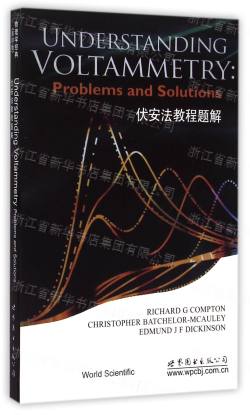-
内容大纲
《伏安法教程题解(英文版)》是作者卡普顿《伏安法教程》的同步习题和解答,为学习伏安法的读者在广阔的理论和实验背景上呈现了大量的习题并给出解答。本书的前几章专注于热动力学、电子输运和扩散的基础理论;紧接着是伏安测量实验和分析,包括大量的宏观和微观伏安法的扩展问题;剩下的章节是有关对流、流体力学电极、均相动力学、吸附和电分析应用等。 -
作者介绍
-
目录
Publisher's Foreword
Glossary of Symbols and Abbreviations
1 Equilibrium Electrochemistry and the Nernst Equation
1.1 Cell Thermodynamics
1.2 The Nernst Equation
1.3 The Nernst Equation
1.4 The Nernst Equation
1.5 Theory of the Nernst Equation
1.6 The Debye-Htickel Limiting Law
1.7 CeU Reaction and Equilibrium Constant
1.8 Ceil Reaction and Equilibrium Constant
1.9 Cell Reaction and Solubility Product
1.10 Cell Reaction and pKa
1.11 Cell Thermodynamics and Temperature
1.12 Cell Thermodynamics and Temperature
1.13 Cell Energetics
1.14 Cell EMF and pH
1.15 Cell Reaction and Equilibria
1.16 Cell Reaction and Kw
1.17 Cell Reaction and Disproportionation
1.18 Fuel Cell Energetics
1.19 Fuel Cell Energetics
1.20 The Influence ofTemperature on the Self-Ionisation ofWater
1.21 Cell Reaction and Complexation
1.22 Reference Electrodes
1.23 Formal Potentials
1.24 Formal Potentials
1.25 Standard Potentials and pH
1.26 Standard Potentials and pH
1.27 Standard Potentials and pH
2 Electrode Kinetics
2.1 Faraday's Laws of Electrolysis
2.2 Electrodeposition
2.3 Tafel Analysis: One-Electron Processes
2.4 Tafel Analysis: Electrochemically Reversible Processes
2.5 Tafel Analysis: Mass Transport Correction
2.6 Tafel Analysis: Two-Electron Processes
2.7 The Butler-Volmer Equation and the Nernst Equation
2.8 The Hydrogen Evolution Reaction
2.9 Requirement for Supporting Electrolyte
2.10 Frumkin Corrections
2.11 Marcus Theory and Standard Electrochemical Rate Constants
2.12 Marcus Theory and Butler-Volmer Kinetics
2.13 Marcus Theory and the Role of Solvent
2.14 Marcus Theory and the Inverted Region
3 Diffusion
3.1 Fick's Laws of Diffusion
3.2 Fick's Laws of Diffusion
3.3 Diffusion Distances
3.4 The Cottrell Equation
3.5 Derivation of the Cottrell Equation
3.6 Diffusion and Root-Mean-Square Displacement
4 Cyclic Voltammetry at Macroelectrodes
4.1 Cyclic Voltammetry: Electrochemically Reversible Voltammetry
4.2 Cyclic Voltammetry: Electrochemically Irreversible Voltammetry
4.3 Reversible vs Irreversible Voltammetry
4.4 Voltammetric Diagnostics
4.5 Voltammetry and Scan Rate Effects
4.6 Ferrocene Voltammetry
4.7 Ferrocene Voltammetry
4.8 Features of Cyclic Voltammograms
4.9 Derivation of the Randles-gev~ik Equation
4.10 Reversible Two-Electron Transfer
4.11 The Influence of pH on Cyclic Voltammetry
4.12 The Scheme of Squares
4.13 The EE-Comproportionation Mechanism
5 Voltammetry at Microelectrodes
5.1 Steady-State Concentration Profile in Spherical Space
5.2 Current Transients at a Spherical Electrode
5.3 Linear vs Convergent Diffusion
5.4 Dissolution of Microparticles
5.5 Steady-State Limiting Current at a Microdisc
5.6 Microdisc vs Planar Electrode
5.7 The Shoup-Szabo Equation
5.8 Steady-State Electrolysis
5.9 Effect of Unequal Diffusion Coefficients
5.10 Temperature Effects on Steady-State Currents
5.11 ECE Mechanism at a Microdisc Electrode
5.12 ECI Mechanism at a Microdisc Electrode
5.13 Size Effects on Half-Wave Potentials
5.14 Extracting Parameters from Microdisc Chronoamperometry...
5.15 Extracting Parameters from Microdisc Chronoamperometry...
6 Voltammetry at Heterogeneous Surfaces
6.1 Graphitic Electrodes
6.2 Carbon Nanotubes and Their Reactivity
6.3 Highly Ordered Pyrolytic Graphite and the Infuence of Defects
6.4 Advantages of Arrays
6.5 Diffusional 'Cases' .
6.6 Geometry of a Regular Array
6.7 Analysis of Diffusion to Electrode Arrays
6.8 Partially Blocked Electrodes
7 Cyclic Voltammetry: Coupled Homogeneous Kinetics and Adsorption
7.1 EE Mechanism and Comproportionation
7.2 EE mechanism: The Reduction of [(~/6-C6Me6)2Ru] [BF412
7.3 EC2 Mechanism: The Reduction of the 2,6-Diphenyl Pyrylium Cation
7.4 Analysis of an Unknown Reaction Mechanism
7.5 EC Mechanism: Diethyl Maleate
7.6 ECE Mechanism: p-chlorobenzonitrile
7.7 ECE vs DISP 1: Voltammetry of Fluorescein
7.8 Reduction of Anthracene in DMF
7.9 CE Mechanism
7.10 EC' Mechanism
7.11 EC' Mechanism: Cysteine and Ferrocyanide
7.12 EC' Mechanism: Oxygen and Anthraquinone
7.13 Chronoamperometry of Adsorbed Species
7.14 Voltammetry of an Ideal Adsorbed Species
7.15 Non-Ideal Adsorbed Species
7.16 Irreversible Electron Transfer and Adsorbed Redox Species .
7.17 Voltammetry of Ferrocyanide/Ferricyanide
8 Hydrodynamic Electrodes
8.1 Channel Electrodes and Limiting Currents
8.2 Channel Electrodes and Reynolds Number
8.3 Flow to Rotating Discs and in Channels
8.4 Channel Electrodes and ECE Processes
8.5 Channel Electrodes and ECE Processes
8.6 Channel Electrodes and Entry Length
8.7 Channel Electrpdes and Diffusion Coefficients
8.8 Channel Elecffodes and Current Distribution
8.9 Wall-Jet Electrodes and Current Distribution
8.10 Wall-Jet Electrodes and Diffusion Coefficients
8.11 Wall-Jet Electrode and a DISP 1 Process
8.12 Wall-Jet Electrode and EC Processes
8.13 Sono-Voltammetry
8.14 Rotating Disc Electrodes and Reynolds Number
8.15 Wall-Jet and Rotating Disc Electrodes
8.16 Rotating Disc Electrodes and ECE Processes
9 Vohammetry for Electroanalysis
9.1 Electrochemical Sizing of Gold Surfaces
9.2 Differential Pulse Voltammetry
9.3 Square-Wave Voltammetry
9.4 Square-Wave Voltammetry and Dissolved Oxygen
9.5 Stripping Voltammetry
9.6 Analysis of DNA
9.7 The Clark Cell
9.8 Calibration and Limits of Detection
9.9 Enzyme Electrodes
9.10 Glucose Biosensors
9.11 Detection of Vitamin B12
9.12 The Anodic Stripping Voltammetry of Industrial Effluent
9.13 Adsorptive Stripping Vohammetry at Carbon Nanotube Modified Electrodes
9.14 Surface Modified Electrodes
9.15 Electron Transfer Rates at Carbon Electrodes
10 Voltammetry in Weakly Supported Media: Migration and Other Effects
10.1 Coulomb's Law
10.2 The Nernst-Planck Equation
10.3 Migration and the Electric Field
10.4 Transport Numbers and Liquid Junction Potentials
10.5 Transport Numbers and the HittorfMethod
10.6 The Gouy-Chapman Equation
10.7 Ohmic Drop
10.8 The Zero-Field Approximation
10.9 Self-Supported Reduction of the Cobaltocenium Cation
11 Voltammetry at the Nanoscale
11.1 Debye Length vs Diffusion Layer Thickness
11.2 Altered Electrode Kinetics and Reactivity at the Nanoscale
11.3 Nanoparticles: Case 4 Behaviour
11.4 'Coulomb Staircase' Effects
11.5 Ultrafast 'Single Molecule' Voltammetry
11.6 Thin-Layer Effects in Nanoscale Voltammetry
11.7 Voltammetry in a Nanochannel
Index
同类热销排行榜
- 故宫日历(公历2017年)(精)26.4
- 时间简史(插图版)18
- 工程数学线性代数(第6版十二五普通高等教育本科国家级规划教材)7.76
- 昆虫记(精)/经典译林8.72
- 数控铣床综合实训教程19.2
- 昆虫记(插图典藏本)(精)11.2
- 化工制图习题集(普通高等教育规划教材)7.2
- 化工制图(普通高等教育规划教材)15.8
- 生命急救技能14
- 时间简史(普及版)(精)15.2
推荐书目
-

孩子你慢慢来/人生三书 华人世界率性犀利的一枝笔,龙应台独家授权《孩子你慢慢来》20周年经典新版。她的《...
-

时间简史(插图版) 相对论、黑洞、弯曲空间……这些词给我们的感觉是艰深、晦涩、难以理解而且与我们的...
-

本质(精) 改革开放40年,恰如一部四部曲的年代大戏。技术突变、产品迭代、产业升级、资本对接...

 [
[
